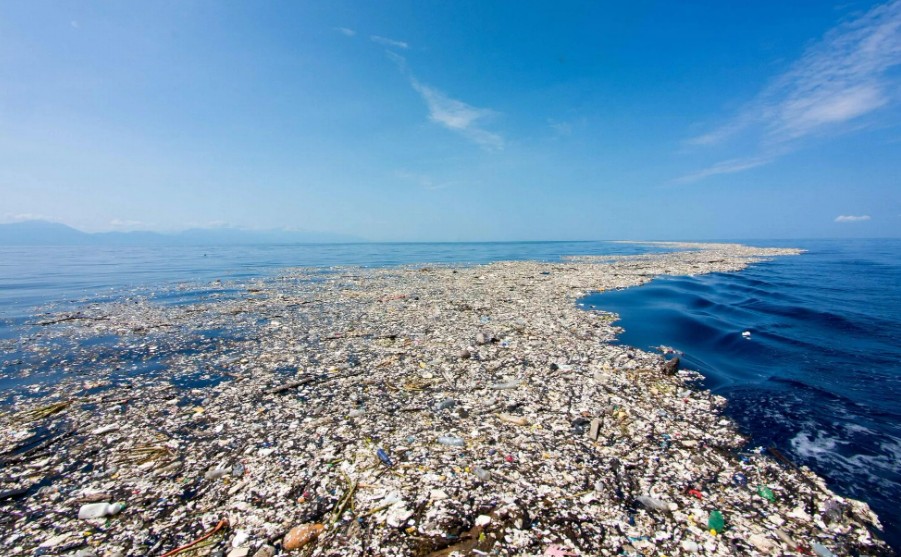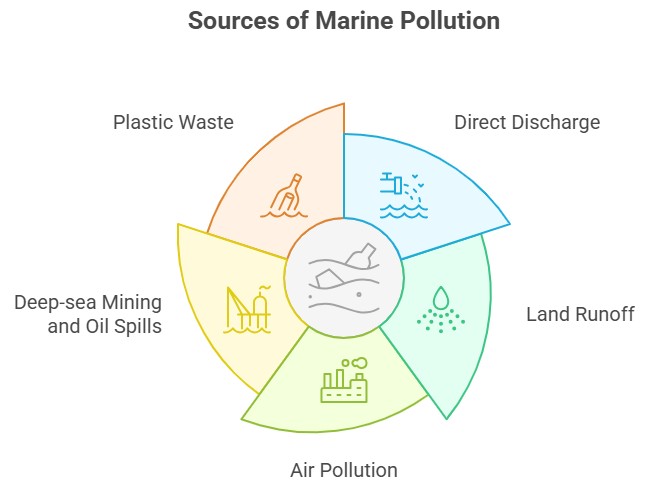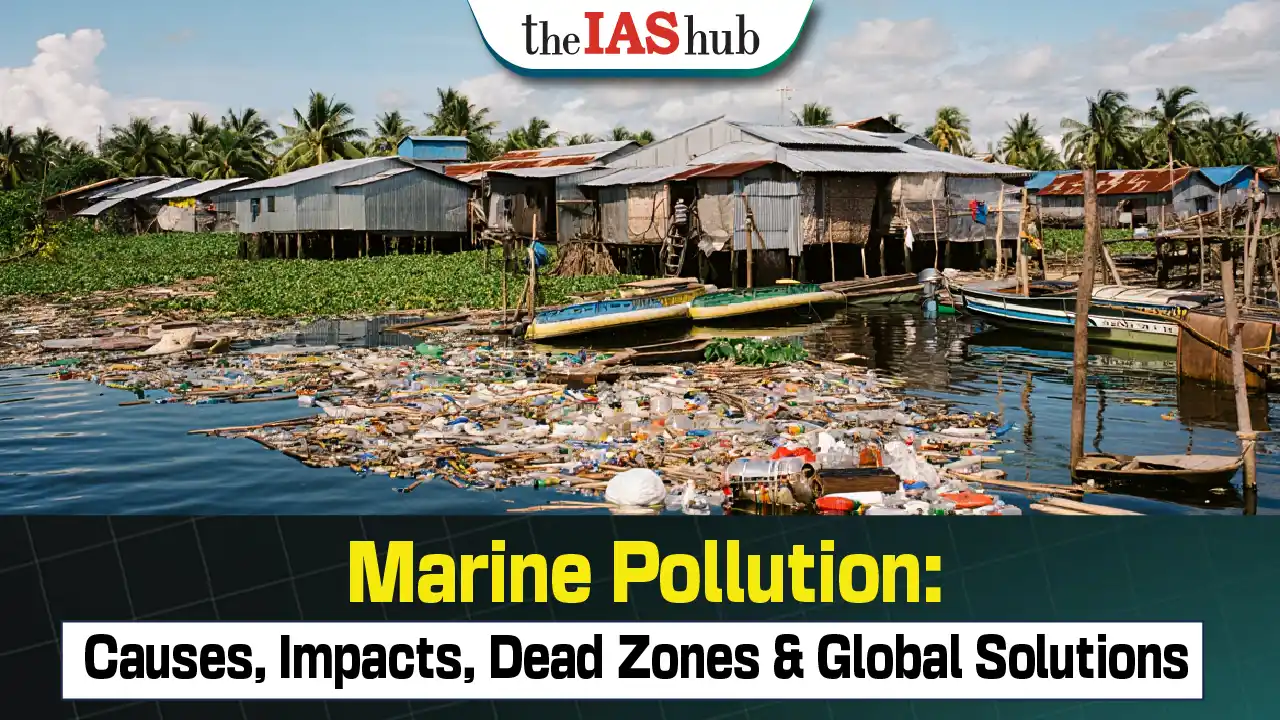Marine pollution, the introduction of substances or energy into the oceans and seas, is an alarming and growing issue. It not only threatens marine life but also endangers human health, disrupts ecosystems, and stifles the economy.

Causes of Marine Pollution
- Direct Discharge: Direct discharge is a major cause of marine pollution. Wastewater, sewage, and garbage from homes and industries often find their way directly into the sea without any treatment, contaminating the waters with various pollutants.
- Land Runoff: Land runoff happens when water from rain or melting snow carries pollutants from the land into the ocean. These pollutants can include pesticides, fertilizers, and other chemicals from agricultural areas, or oil, grease, and toxic chemicals from urban areas.
- Air Pollution: Air pollution is another significant cause. Particulate matter and chemicals from industrial emissions can fall directly into the ocean or be carried there by wind currents.
- Deep-sea Mining and Oil Spills: Deep-sea mining and oil spills also contribute significantly to marine pollution. Mining activities release heavy metals into the sea, while oil spills introduce large volumes of petroleum products. Notable incidents like the Deepwater Horizon oil spill in 2010 released an estimated 4.9 million barrels of oil into the Gulf of Mexico, causing significant damage to marine life.
- Plastic Waste: Plastic waste is another significant contributor. An estimated 8 million tons of plastic waste enter the oceans each year, as per data from the United Nations. This waste takes hundreds of years to decompose, during which time it can harm marine animals and birds and degrade marine ecosystems.

Impacts of Marine Pollution
- Loss of Biodiversity: Pollutants can cause direct mortality in marine species, or they can affect reproduction, leading to long-term declines in populations.
- Damage to Coral Reefs: Coral reefs, vital marine ecosystems, are particularly susceptible to pollution. According to a 2021 report by the United Nations, 50% of the world's coral reefs have died in the last 30 years, and 90% could die within the next century unless urgent action is taken.
- Bioaccumulation: Toxic substances like heavy metals and persistent organic pollutants can accumulate in marine organisms and then move up the food chain, leading to health risks for humans who consume contaminated seafood.
- Ocean Acidification: Increased CO2 emissions are not only causing global warming but are also leading to ocean acidification, which harms shell-building animals and other marine life.
Counter Strategies to Control Marine Pollution
- Strict Laws and Regulations: Stronger enforcement of laws against illegal dumping in the ocean and stricter standards for wastewater treatment can reduce the direct discharge of pollutants.
- Promoting Sustainable Practices: Encourage sustainable farming and industrial practices to minimize runoff.
- Recycling and Reducing Waste: Reducing, reusing, and recycling materials, especially plastics, can help decrease the volume of waste that ends up in the ocean.
- Education and Public Awareness: Educate the public about the impacts of marine pollution and how individual actions can contribute to or help solve the problem.
International Initiatives to Tackle Marine Pollution
- The United Nations Environment Programme (UNEP) has several initiatives aimed at combating marine pollution. The Global Programme of Action for the Protection of the Marine Environment from Land-Based Activities (GPA) is an intergovernmental mechanism directly addressing the connectivity between terrestrial, freshwater, coastal, and marine ecosystems.
- In addition, there's the Clean Seas campaign launched in 2017 by UNEP, which aims to engage governments, the public, and the private sector in the fight against marine plastic pollution.
Indian Initiatives to Tackle Marine Pollution
- India, with its vast coastline of over 7500 km, has also been actively participating in measures to control marine pollution. The Indian government launched the “Swachh Sagar Abhiyan” in 2017 to mark International Coastal Cleanup Day. The campaign aimed to raise awareness about marine pollution and mobilize communities to clean and protect coastal and marine environments.
- India is also a signatory to the International Convention for the Prevention of Pollution from Ships (MARPOL) and has adopted national regulations aligned with this convention to prevent marine pollution from ships.
Dead Zones and their Impact on Marine Ecosystems
- Oceanic dead zones, also known as hypoxic zones, are areas in oceans, large lakes, and reservoirs that suffer from low oxygen (hypoxia), which is insufficient to support most marine life.
- This environmental phenomenon is a serious concern as it threatens biodiversity, disrupts ecosystems, and poses economic ramifications. Understanding its causes, impacts, and possible mitigation strategies is key to addressing this issue.
Causes of Dead Zones
- Eutrophication: Eutrophication is the primary cause of dead zones. It involves the excessive enrichment of waters with nutrients, primarily nitrogen, and phosphorus, often due to runoff from the land, which causes a dense growth of plant life.
- Agricultural Runoff: Agricultural runoff is a significant contributor to eutrophication. Fertilizers used in farming, rich in nitrogen and phosphorus, often find their way into rivers and eventually the ocean. This nutrient pollution can stimulate an overgrowth of algae, which eventually die and decompose.
- Industrial and Domestic Sewage: Wastewater and sewage from industrial and domestic sources are also loaded with nutrients. If not appropriately treated, these nutrients can significantly contribute to the creation of dead zones.
- Climate Change: Climate change exacerbates the problem of dead zones. Warmer waters hold less oxygen, and altered weather patterns can lead to more runoff.
Impacts of Dead Zones
- Loss of Biodiversity: The low oxygen levels in dead zones can lead to mass die-offs of marine life, resulting in a severe loss of biodiversity. This has serious consequences for the entire food web.
- Economic Impact: Dead zones can devastate local economies that depend on fishing, tourism, and other marine-related activities. The Gulf of Mexico dead zone, for instance, is estimated to cost the U.S. seafood and tourism industries $82 million a year.
- Disruption of Ecosystem Functioning: Dead zones alter the nutrient cycles in marine environments, affecting ecosystem functioning. For example, hypoxic conditions can release nitrogen in a form that is unusable by most organisms.
Strategies to Address the Issue of Dead Zones
- Sustainable Agricultural Practices: Promoting sustainable agricultural practices that minimize the use of fertilizers or use them more efficiently can help reduce nutrient runoff.
- Improved Wastewater Treatment: Wastewater treatment facilities can be improved to better remove nutrients from industrial and domestic sewage before it is discharged.
- Restoration of Wetlands: Wetlands act as natural filters for nutrients. Restoring and preserving them can help reduce the amount of nutrients reaching the oceans.
- Reduction of Greenhouse Gas Emissions: Addressing climate change by reducing greenhouse gas emissions can also help mitigate the problem of dead zones.
Conclusion
Marine pollution poses a grave threat to our planet, but it's a problem we can solve. By taking steps to reduce waste, regulate and clean up pollution, and protect vulnerable marine ecosystems, we can ensure that future generations inherit an ocean full of life, not pollution. However, it will require the active participation of not just governments and organizations but also every individual on this planet.














